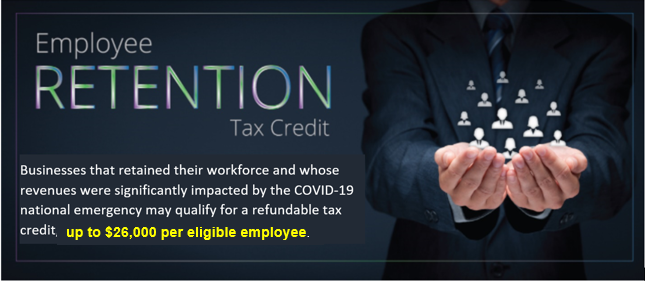ERC Tax Credit
The ERC Tax Credit – or Employee Retention Tax Credit – was extended beyond its original expiration date of December 31, 2020. This was done under the federal coronavirus stimulus bill in late December of 2020. It was extended again by the American Rescue Plan Act (ARPA) – as amended by the federal infrastructure bill – through September 30, 2021.
The ERC tax credit can be claimed retroactively and remains available for eligible companies that have not yet claimed them. This may be the fastest and easiest way to quickly increase qualifying companies’ after-tax bottom lines.
[WP4M_download_button dl=https://peakprofitsadvisors.com/wp-content/uploads/2021/11/ERC-Employer-Tax-Credit-Flyer-Update.pdf redirect=https://gmg.me/activate/112150 button=GetInstantAccess /]
According to reporting at Accounting Today…
“The package expands the following tax provision:
The ERC Tax Credit (ERC): The bill extended and expanded the credit by providing a 70% credit for up to $10,000 in creditable wages per quarter. It also reduced companies’ gross receipts decline to qualify to 20 percent from 50 percent. This employer tax credit gives businesses of all sizes, including nonprofits, a payroll tax credit for wages paid during a suspension of their business operations or periods where they have experienced significant revenue losses.”
The ERC Tax Credit is a federal hiring incentive established with the 2020 CARES Act to help mitigate the employment cutbacks caused by the coronavirus pandemic. However, there is a previous version of the ERC Tax Credit focused on Disaster Relief that is also available.
To clarify the differences between the two, the current version will be referred to below as COVID ERC, or C-ERC, and the previous version as Disaster ERC, or D-ERC.
COVID-ERC (ERC Tax Credit)
The Coronavirus Aid, Relief, and Economic Security (CARES) Act created a new employee retention tax credit for employers who closed their business operations, partially or fully, and experienced significant revenue losses as a result of COVID-19.
Who Is Eligible?
Private employers, including non-profits, carrying on a trade or business in 2020 through September 30, 2021 that:
- Had operations partially or fully suspended as a result of orders from a governmental authority due to COVID-19, or
- Experienced a decline in gross receipts by more than 20% (previously 50% in the CARES Act) in a quarter compared to the same quarter in 2019. Eligibility ends when gross receipts in a quarter exceed 80% of the same 2019 quarter.
As of June 1, 2020, employers who received a Paycheck Protection Program Loan (PPP) were not eligible for this tax credit. However, later coronavirus relief packages allowed access to both programs while avoiding double-dipping. Any payroll costs covered by a PPP can’t also be used to qualify for the ERC tax credit.
How Much is the ERC Tax Credit?
C-ERC is a 70% tax credit (previously 50%) for the first $10,000 of earnings paid per quarter after March 12, 2020 and before September 30, 2021 per eligible employee. This amount can include the employer portion of health benefits.
For every eligible employee who earned $10,000 or more per quarter during this time period the C-ERC provides the employer with a $7,000 tax credit. This is the maximum tax credit allowed per quarter).
For January to September 30, 2021, this represents a potential $21,000 tax credit per employee kept on the payroll and a combined $26,000 per eligible employee maximum for 2020 and 2021 as follows:
- 50% of first $10K in 2020 compensation = $5,000/employee
- 70% of first $10K per quarter in Q1-3 2021 compensation = $21,000/employee
How Is The Credit Taken?
The COVID ERC tax credit is applied against the employer portion of payroll taxes. And according to the IRS “If the employer’s employment tax deposits are not sufficient to cover the credit, the employer may get an advance payment from the IRS.”
This makes it a lot like a tax refund, with similar rapid cash flow benefit.

For more information, see these IRS FAQs.
DISASTER-ERC
2019’s Further Consolidated Appropriations Act signed included an extension to the existing Employee Retention Credit for employers affected by qualified disasters that occurred during 2018 and 2019. This Disaster-ERC tax credit has been around for years, specifically focused on areas of disaster.
Who Is Eligible?
Employers who operated in a qualified disaster zone and become inoperable due to the disaster and they continued to pay or incur wages for eligible employees. As of June 2, 2020, these areas included 282 counties in the following states:
Alabama, Alaska, Arkansas, California, Florida, Georgia, Hawaii, Indiana, Iowa, Mississippi, Missouri, Nebraska, North Carolina, Ohio, Oklahoma, South Carolina, South Dakota, Texas, and Wisconsin.
How Much is the Disaster Tax Credit?
D-ERC is a 40% tax credit for up to $6,000 of earnings paid to each eligible employee (making the maximum credit $2,400 per eligible employee). As reported by the Journal of Accountancy, this was increased in the coronavirus stimulus bill in December 2020 as follows:
“The bill allows a tax credit of 40% of wages (up to $6,000 per employee) to employers who conducted an active trade or business in a qualified disaster zone (as defined in the bill). The credit applies to wages paid without regard to whether the employee performed any services associated with those wages.”
How Is The Credit Taken?
The Disaster-ERC is a Federal income tax credit and should be filed with the employer’s tax return.
Summary
Most businesses want to know “what do I qualify for”. Legislation related to Hiring Incentives is constantly changing due to the COVID-19 crisis. We stay informed and educated about these constant changes to ensure our clients get the highest amount possible on these employer tax incentives.
To see how much your business may be eligible for, click the button below...

